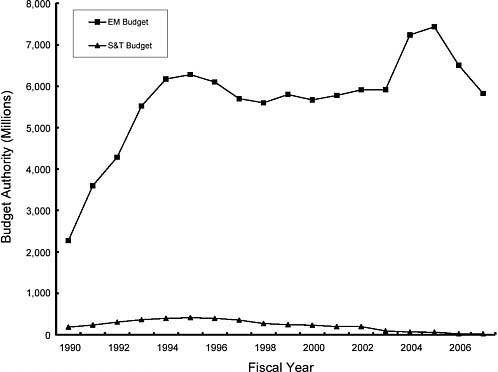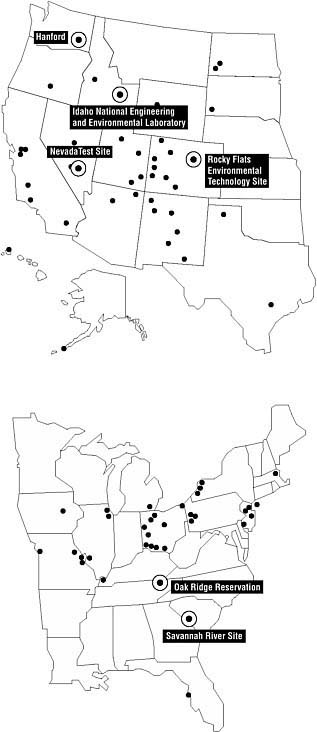1
Introduction
Beginning with the Manhattan Project and extending through the Cold War, the U.S. government constructed and operated a massive industrial complex to produce and test nuclear weapons and related technologies. At its peak this complex encompassed over 100 distinct sites in 31 states and one territory with a total area of over 2 million acres (see Figure 1). Most of the production and testing activities were carried out at six sites: Hanford, Idaho National Laboratory, Nevada Test Site, Oak Ridge Reservation, Rocky Flats Site, and Savannah River Site (see Sidebar 1). This complex produced large quantities of nuclear explosive materials—plutonium, highly enriched uranium, and tritium—over a period of about four decades.
Starting in the 1980s, large parts of this industrial complex were shut down permanently or placed on standby, and the U.S. government began a costly effort to clean up the materials, wastes, and environmental contamination resulting from weapons production activities. In 1989, Congress created the Office of Environmental Management (EM) within the Department of Energy (DOE) to manage this cleanup effort. To date, this cleanup program has cost U.S. taxpayers about $102 billion. This program is planned to continue for at least another three decades and will ultimately cost several hundreds of billions of dollars.1 It is the largest single environmental cleanup program in the federal government and arguably the largest such effort worldwide (NRC, 1999g).
From its inception the cleanup program has faced two fundamental technical challenges: (1) to inventory and characterize the vast array of materials, wastes, and contamination resulting from weapons production, testing, and related activities, and (2) to retrieve, treat, remediate, or dispose of these materials, wastes, and contamination. The ultimate goal of this cleanup effort is to reduce
|
SIDEBAR 1: THE DOE COMPLEX Although the DOE complex encompasses over 100 distinct sites, most of the weapons production and testing activities were conducted at six sites: The Hanford Site is located in southeastern Washington state and covers an area of about 1450 square kilometers (560 square miles). Production of materials for nuclear weapons took place here from the 1940s until mid-1989. The site contains several plutonium production reactors, chemical separations plants, and solid and liquid waste storage and disposal sites. The Idaho National Laboratory, first established as the Nuclear Reactor Testing Station, occupies 2300 square kilometers (890 square miles) in a remote desert area along the western edge of the upper Snake River Plain. The site was established as a building, testing, and operating station for various types of nuclear reactors and propulsion systems, and it also manages spent fuel from the naval reactors program. The site was also used to dispose of wastes from Rocky Flats and elsewhere. The Nevada Test Site, which occupies about 3500 square kilometers (1350 square miles) in southern Nevada, was the primary location for atmospheric and underground testing of the nation’s nuclear weapons starting in 1951. It is also used for disposal of low-level wastes from other DOE sites. The Oak Ridge Reservation covers an area of approximately 155 square kilometers (60 square miles) and is located about 10 kilometers (6 miles) west of Knoxville, Tennessee. The reservation has three major facilities: the Oak Ridge National Laboratory, the Y-12 Plant, and the K-25 Plant. The laboratory was originally constructed as a research and development facility to support plutonium production technology. The Y-12 Plant was built to produce highly enriched uranium by electromagnetic separation. The K-25 Plant, formerly known as the Oak Ridge Gaseous Diffusion Plant, also was created to produce highly enriched uranium for nuclear weapons. The reservation has waste disposal sites and contaminated buildings and soil. The Rocky Flats Environmental Technology Site was situated on about 2.4 square kilometers (~600 acres) within a 24-square-kilometer (6000 acre) tract near Denver, Colorado, and contained more than 400 manufacturing, chemical processing, laboratory, and support facilities that were used to produce nuclear weapons components. Production activities once included metalworking, fabrication and component assembly, and plutonium recovery and purification. Operations at the site ceased in 1989, and site cleanup was completed in 2006. The Savannah River Site, located near Aiken, South Carolina, covers an area of about 800 square kilometers (300 square miles). The site was established in 1950 to produce special radioactive isotopes (e.g., plutonium and tritium) for use in the production of nuclear weapons. The site contains plutonium and tritium production reactors; chemical processing plants, one of which is still operating; and solid and liquid waste storage sites. Other Sites. Among the more than 100 other sites, the Paducah Plant (Kentucky) and Portsmouth Plant (Ohio) contain large gaseous diffusion plants for enriching uranium that will eventually be decommissioned. The Waste Isolation Pilot Plant in New Mexico hosts an underground repository for disposal of transuranic waste from defense activities. SOURCE: Updated from NRC (2000a). |

FIGURE 2 Federal budget authority for the DOE-EM cleanup program (squares) and the DOE-EM headquarters-directed science and technology (S&T) program (triangles). After DOE-EM adopted project-based budgeting in the early 2000s, some of the headquarters-directed S&T investments were moved to the sites. The S&T budget shown in the figure does not include these site expenditures. SOURCE: NRC (1999g).
short-term risks to site workers and longer-term risks to the people who live near the sites or utilize site resources.2
EM has made major investments in scientific research and technology development to obtain the needed knowledge and tools to meet these challenges. There has been a technology development
program3 within this office since its creation. However, EM headquarters-directed investments in science and technology activities have varied substantially over the past 18 years (see Figure 2), rising from $184 million in fiscal year 1990 to almost $410 million in fiscal year 1995, followed by a decade-long slide to $21.4 million in fiscal year 2006. This slide was prompted by a variety of factors, including concerns about the effectiveness of the program4 as well as changing administration priorities. In the past five years the program has focused almost exclusively on short-term technology development needs to support accelerated site cleanup.
There has been recent renewed interest in cleanup science and technology development by both upper DOE management and Congress. This interest was inspired in part by a congressionally mandated National Research Council study (NRC, 2006a) that evaluated DOE’s plans for retrieval and onsite disposal of certain wastes stored in tanks at the Hanford, Idaho, and Savannah River sites (Figure 1).
The report from that study recommended that DOE initiate a targeted, aggressive, and collaborative research and development program to support its efforts to retrieve waste and clean and close tanks in which the waste is currently being stored. It further recommended that the program last for 10 years, with funding on the order of $50 million per year. This study prompted DOE to request additional funding for science and technology development for its cleanup program in fiscal year 2007, which in turn prompted Congress to request that DOE prepare a technology roadmap.5






